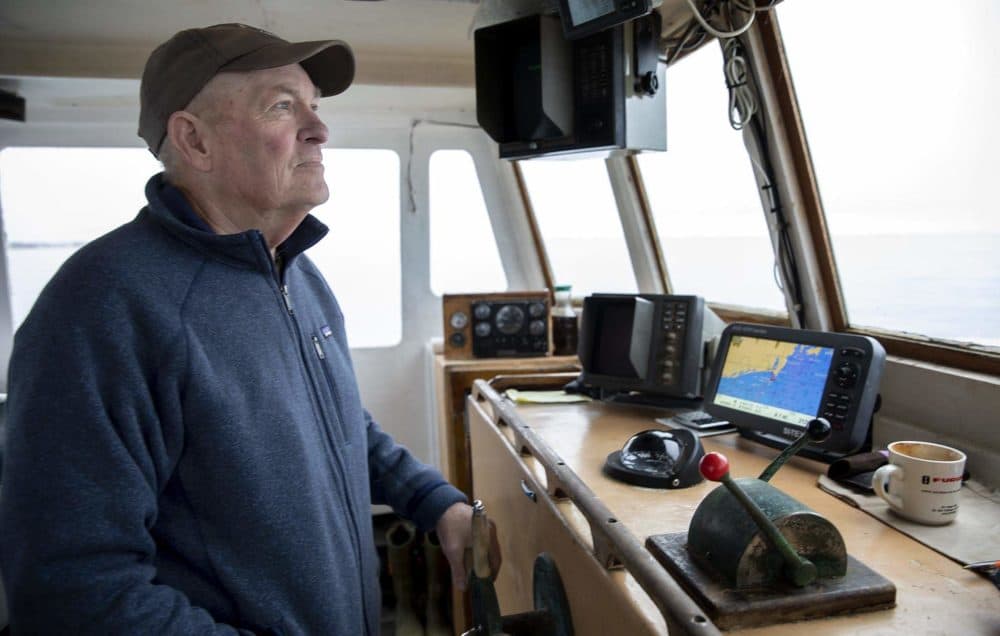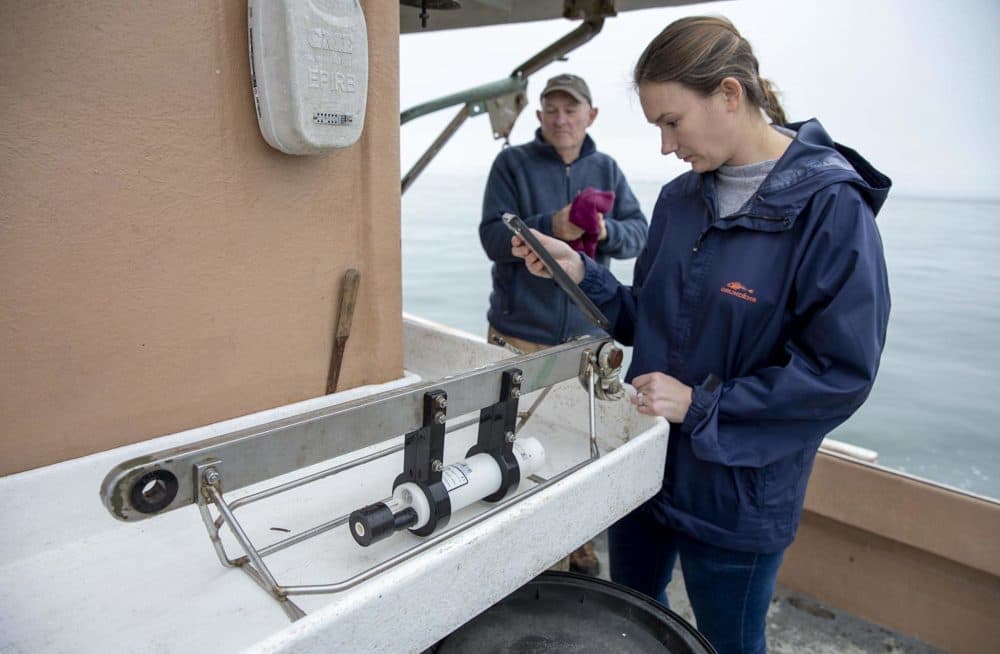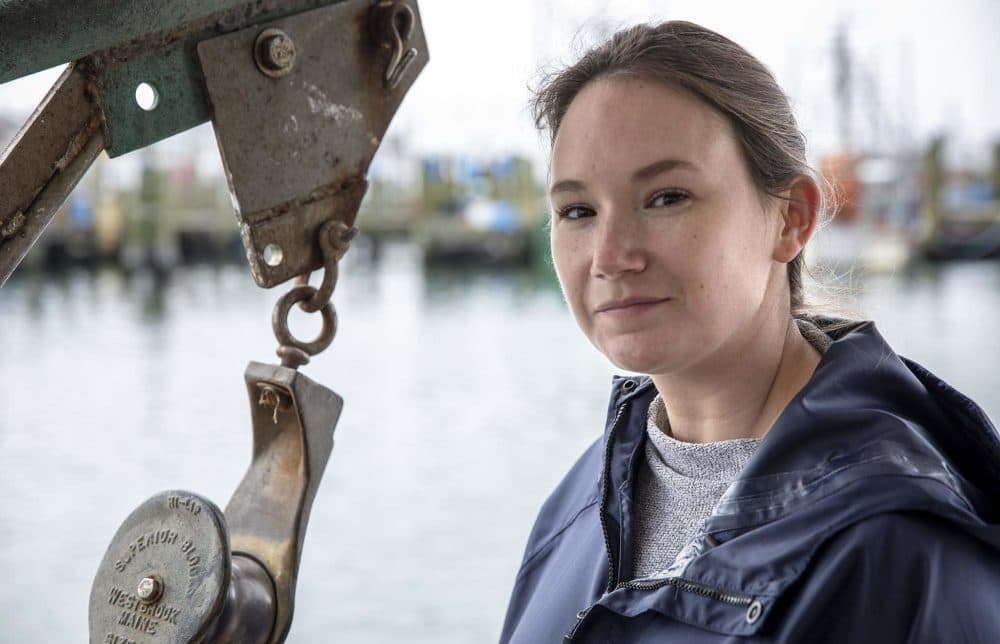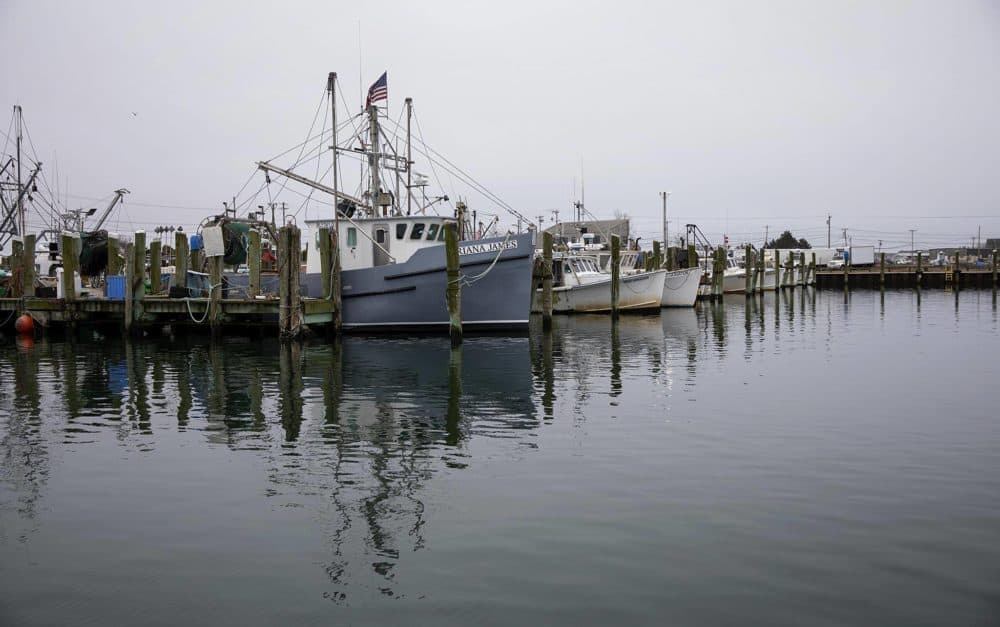Advertisement
Fishermen And Scientists Join Forces To Track Effects Of Climate Change

Last October, lobstermen fishing off the coast of southern New England noticed the lobsters getting more active. That's fairly common, says Mark Sweitzer, a commercial fisherman out of Port Judith, Rhode Island.
“It’s not unusual for there to be a big pop of lobster in September or October,” says Sweitzer. “Fall's our best fishing.”
But along with the lobster came something more unusual: a temperature spike on the seafloor, about 150-200 feet down. The temperature jumped from about 50 degrees to 60 — “a big, big change,” says Sweitzer — and stayed there for 38 days, from October 10 to November 15.
Sea surface temperature can change rapidly, rising or falling with strong winds or a storm. But at the bottom, temperature changes much more slowly. “So to get a temperature change that big on the bottom, that is major,” says Sweitzer. “Something caused that to happen. That wasn’t a few warm nights.”
Sweitzer noted the temperature change because he’s part of a network of fishermen collecting data for the Shelf Research Fleet, a joint venture of the nonprofit Commercial Fisheries Research Foundation and the Woods Hole Oceanographic Institution (WHOI). Since 2014, fishermen have collected information on water temperature and salinity at various depths, and shared that data with WHOI scientists. The goal is to get a better understanding of the rapid changes happening in the ocean, and how those changes may affect fisheries in both the near and distant future.
Scientists already know that the water off the New England coast is warming rapidly. Over the last 30 years, the Gulf of Maine has warmed by .11°F per year — that may not seem like much, but it's three times faster than the global average. And the pace of warming has been speeding up: For the last 15 years, the Gulf has warmed at seven times the global average.
The ocean is also becoming more acidic as it absorbs carbon dioxide; and it's getting saltier in some parts, less salty in others.
All this affects traditional New England fisheries. Lobsters, for instance, thrive in a temperature zone with a sweet spot around 60 degrees. Water over 68 degrees is an “unsuitable habitat for lobster” says Aubrey Ellertson, a research biologist who oversees the Shelf Research Fleet for the Commercial Fisheries Research Foundation. Ocean changes also bring more black sea bass to New England water, which prey on juvenile lobsters.


So many fish, sea turtles, whales and other marine animals are now seeking cooler (or occasionally warmer) waters due to ocean changes, that scientists recently coined a term for the phenomenon: "thermal displacement."
“We’re trying to understand these changing ocean conditions,” Ellertson says. “A lot of people talk about climate change as this global phenomenon. But it’s really come to affect people at a much more local and regional scale.”
Last October, Ellertson started receiving calls and emails from fishermen about the temperature spike. Some of them also reported unusual fish, like summer flounder and triggerfish — “species you wouldn’t typically see that time of year,” says Ellertson. She sent the information to Glen Gawarkiewicz, a physical oceanographer at WHOI who works with the Shelf Research Fleet.
Gawarkiewicz studies “warm core rings," huge eddies that spin off the Gulf Stream and can carry warm, salty water closer to shore. By the time Ellertson contacted Gawarkiewicz in the fall of 2019, he was already on alert, alarmed by data coming from surface water measurements showed three large warm core rings spinning off the Gulf Stream.
Advertisement
Warm core rings are a familiar phenomenon to ocean scientists, says Gawarkiewicz, but they’ve been growing unpredictable. In 2000, the average number of rings jumped from 18 to 33 per year. And they’ve been getting larger and stronger in recent years.
“These warm core rings seem to be affecting the continental shelf in far more dramatic ways than in the past,” he says. “What’s remarkable is just in, say, the last ten years, these rings are able to push water masses almost all the way across the continental shelf.”
That’s what appears to have happened last fall, based on the data scientists have analyzed so far. But Gawarkiewicz says scientists still don't fully understand how warm core rings operate. At least, not yet.
“This is something we really need to understand: Which warm core rings are going to drive warm, salty water across the continental shelf,” says Gawarkiewicz. “This is an open question scientifically, and yet is has a lot of economic and social importance.”
Gaining a better understanding of how climate change is affecting regional waters and local species is critical to the future of New England commercial fisheries, says Ellerston.

“There are certain species that are climate winners and others that are not,” she says. “I think trying to pinpoint what each species is doing and how they’re reacting is really important.”
She points to black sea bass, which are now far more abundant in New England waters than they were in decades past. But fishing quotas are usually based on historical data; that means that Massachusetts, for instance, gets 13 percent of the annual black sea bass haul, while to the south, New Jersey and Virginia get 20 percent. Northern states are now pushing to increase their allocations, and the Atlantic States Marine Fisheries Commission has begun the process of reviewing them.
Another example are Illex or "shortfin" squid, a species that breeds in warm water and has been booming in recent years. The squid are now so plentiful that the Mid-Atlantic Fishery Management Council upped the annual quota in August from 26,000 to 30,000 metric tons.
“The fishermen want to take advantage of those resources,” says Ellertson. “So I think that goes along with wanting better science, trying to inform managers so fishermen are able to harvest the species that are now abundant.”
Aside from the challenges posed by climate change, the New England fishing industry faces another complicating factor this year: COVID-19. With tourism down and restaurants at low capacity, Ellertson says many fishermen have been struggling — working just as hard as in previous years, but getting a lower price for their catch. The federal CARES Act, passed in March, earmarked $300 million dollars for fisheries assistance, but distribution didn't begin until early August.
Despite the social upheaval and economic stress, the research has continued. As it should, says lobsterman Mark Sweitzer.
"It’s tough to define essential workers, but certainly monitoring the health of the ocean is essential," says Sweitzer, who says he’s doing fine, by the way, selling lobsters off the dock. Even with a pandemic staring you in the face, he adds, the ocean is still changing.
"That's not all going to go away because, you know, a percentage of our population is ill or hunkering down because of the virus," says Sweitzer. "I don’t want to use the trite expression life goes on, but it does. It really does."

The fishermen’s data has become even more valuable lately, with several federal research cruises cancelled because of COVID-19. It's a point worth noting, given the historically fraught relationship between fishermen and scientists.
“There was always this perception that scientists would collect data from fishermen and then use it against them,” says Sweitzer. “There was always that perception that they weren’t going to listen to anything you said.”
Sweitzer says those ideas are changing, as fishermen increasingly see the effects of climate change firsthand, and also see that data may be able to help their profession.
“This data may not be directly influencing how I lobster the next two or three years, whatever I got left in the business,” says Sweitzer. “But it’s going to help somebody chasing squid, it might help somebody chasing lobsters. It might help somebody down the line.”
This segment aired on August 14, 2020.
